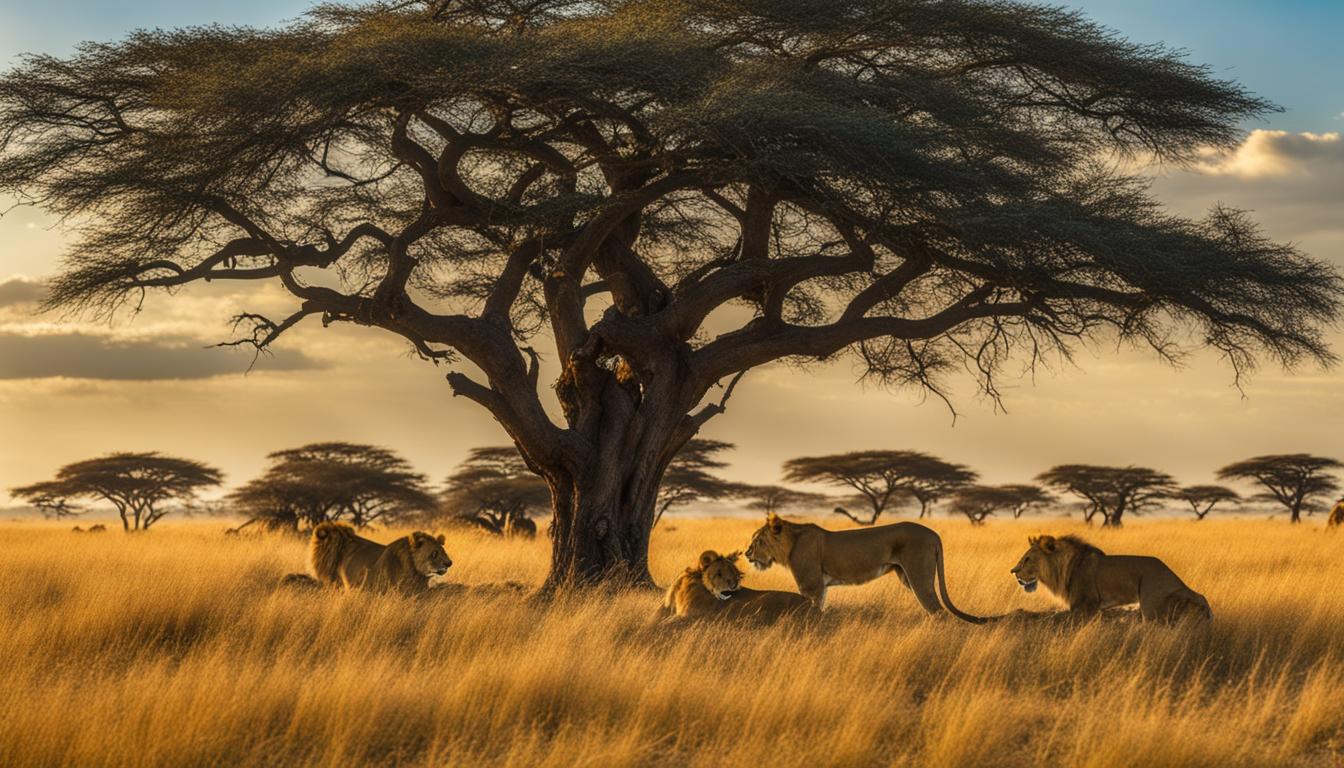Lions have a fascinating habitat range that spans across various regions. While they once roamed vast areas of Europe, Africa, and Asia, they have unfortunately disappeared from 94% of their historic range. Today, African lions mainly inhabit Sub-Saharan Africa, including West and Central Africa, East Africa, and Southern Africa. On the other hand, the Asiatic lions are primarily found in the Gir Forest National Park in the Indian state of Gujarat.
Key Takeaways:
- Lions have disappeared from 94% of their historic range.
- African lions are mainly found in Sub-Saharan Africa.
- Asiatic lions are primarily found in the Gir Forest National Park in India.
Lion Habitat in West and Central Africa
Lions in West and Central Africa face significant challenges and are experiencing severe population declines. In fact, nearly all lion populations in this region have a 67% chance of declining by 50% over the next 20 years. The primary threats to lion populations in West and Central Africa are bushmeat hunting and human-animal conflicts due to open reserve systems.
Table: Lion Population Decline in West and Central Africa (Percentage)
| Year | Lion Population Decline |
|---|---|
| 2010 | 40% |
| 2015 | 52% |
| 2020 | 67% |
The table above illustrates the alarming decline in lion populations in West and Central Africa. From 2010 to 2020, the lion population has decreased by 67%, highlighting the urgent need for conservation efforts in this region. Without immediate action, we risk losing these magnificent creatures forever.
“The lion, Africa’s iconic predator, is facing an uncertain future in West and Central Africa,” says Dr. Jane Wilson, a renowned wildlife conservationist.
Our conservation efforts must focus on combating bushmeat hunting and implementing strategies to mitigate human-animal conflicts. Only through collective action can we ensure the preservation of lion habitats and their rightful place in the African wilderness.”
Lion Habitat in East Africa
East Africa is a critical region for lion conservation, despite the significant decrease in lion populations over the past two decades. The Serengeti National Park in Tanzania and Maasai Mara National Reserve in Kenya are vital areas for lion habitat and protection. These iconic landscapes provide the necessary resources and space for lions to thrive, supporting one of the largest lion populations on the continent.
“Conservation is not just about protecting the lions; it’s about ensuring the ecological balance of the entire ecosystem.”
However, experts warn of potential challenges that could impact lion populations in East Africa. Inadequate protection measures and the rapid growth of human populations pose a threat to these majestic creatures. Without increased conservation efforts and improved habitat protection, there is a 37% chance that lion populations may decline by 50% in the next two decades.
Lion Habitat Challenges in East Africa
The following factors contribute to the vulnerability of lion habitats in East Africa:
- Habitat Loss: As human populations expand, lion habitats are increasingly encroached upon by agriculture and infrastructure development.
- Human-Animal Conflict: Competition for resources, such as water and prey, can lead to conflicts between local communities and lions.
- Poaching: Illegal hunting and the trade of lion parts still occur, posing a significant threat to lion populations.
| Lion Habitat Challenges in East Africa | Impact |
|---|---|
| Habitat Loss | Encroachment from human activities reduces available space for lions and disrupts their natural behavior. |
| Human-Animal Conflict | Conflicts between local communities and lions can result in retaliatory killings and habitat fragmentation. |
| Poaching | Illegal hunting and trade of lion parts threaten the survival of these magnificent animals. |
The conservation organizations and local communities in East Africa are working tirelessly to address these challenges and protect lion habitats. Collaborative efforts, such as community-led conservation initiatives and sustainable tourism practices, can help mitigate the threats and ensure the long-term survival of lions in this region.
Lion Habitat in Southern Africa
Southern Africa is home to a significant population of lions, thanks to well-managed conservation areas and successful preservation efforts. Countries such as Botswana, Namibia, South Africa, and Zimbabwe have seen an increase in lion numbers, bucking the trend of declining populations in other regions of Africa. However, challenges remain in ensuring the long-term survival and growth of lion populations in Southern Africa.
Habitat Preservation
Lion habitat preservation is crucial for maintaining and expanding the population in Southern Africa. Protected areas with sufficient space, adequate prey availability, and minimal human disturbances have been instrumental in supporting lion populations. Fenced populations within these conservation areas have experienced less decline compared to their unfenced counterparts, highlighting the importance of habitat protection.
Habitat Requirements
Lions in Southern Africa inhabit various ecosystems, including grasslands, savannas, and open woodlands. These habitats offer the necessary cover for denning and hunting, providing lions with the opportunity to thrive. However, habitat loss and limited space pose challenges for further population growth. As human populations expand and encroach upon lion territories, it becomes increasingly important to protect and secure suitable habitats for their survival.
| Country | Lion Population (2014) | Population Change (1993-2014) |
|---|---|---|
| Botswana | 3,000 | +6% |
| Namibia | 1,500 | +21% |
| South Africa | 2,000 | +2% |
| Zimbabwe | 1,500 | +2% |
The table above showcases lion populations and their changes in four Southern African countries. Despite the positive growth, it is important to note that these populations are still vulnerable to habitat loss and other threats. Continued efforts in preserving lion habitats, implementing effective conservation strategies, and mitigating human-wildlife conflicts are essential for the long-term sustainability of lion populations in Southern Africa.
Lion Habitat in India
The only surviving population of Asiatic lions is found in the Gir Forest National Park in Gujarat, India. Historically, Asiatic lions ranged across several countries but were pushed to the brink of extinction due to severe hunting. In recent years, conservation efforts have helped increase the population to an estimated 674 individuals. However, there is a debate regarding the need for translocation to protect against potential risks in a single population.
Conservation Challenges in India
The habitat of Asiatic lions in India faces various challenges, including habitat destruction and fragmentation. As human populations and agricultural activities continue to expand, lion habitats are being encroached upon, resulting in the loss of suitable living space for these magnificent creatures. The increasing human presence also heightens the risk of human-animal conflicts, further endangering the lion population.
Additionally, the limited range of the Gir Forest National Park poses a risk to the long-term survival of Asiatic lions. With the entire population concentrated in one area, a single catastrophic event like a disease outbreak or natural disaster could potentially wipe out the entire population. To mitigate this risk, there have been discussions about translocating some lions to other suitable habitats within and outside of India.
“Conservation efforts have been successful in increasing the Asiatic lion population in India. However, it is crucial to address the challenges of habitat destruction and the need for genetic diversity to ensure the long-term survival of this species.” – Wildlife Conservation Expert
| Challenges | Solutions |
|---|---|
| Habitat Destruction | Implement strict regulations to prevent further habitat destruction and promote sustainable land use practices. |
| Genetic Diversity | Explore translocation options to establish additional populations, ensuring genetic diversity and reducing the risk of a single catastrophic event. |
| Human-Animal Conflict | Engage local communities in conservation efforts, providing education and support to minimize conflicts and promote coexistence. |
Lion Habitat Requirements
Lions are majestic creatures that require specific habitat conditions to thrive. They primarily inhabit grasslands, savannas, dense scrub, and open woodlands, where they have enough cover for denning and hunting. However, lions cannot survive in tropical rainforests and deserts, as these habitats lack the necessary prey and shelter. Understanding their habitat requirements is crucial for their conservation and protection.
In Africa, the Serengeti National Park in Tanzania and Maasai Mara National Reserve in Kenya are key areas for lion conservation. These regions provide the ideal combination of open grasslands and scattered trees, creating a perfect hunting ground for lions. The availability of prey, such as wildebeest and zebras, ensures a continuous food source for these magnificent predators.
“Lions are adaptable to a range of habitats as long as their prey is available.”
In India, the Gir Forest National Park in Gujarat is home to the only surviving population of Asiatic lions. This park consists of deciduous forests, grasslands, and scrub jungles, providing the necessary habitat for lions to thrive. Efforts to protect and manage this unique habitat have led to an increase in the population of Asiatic lions in recent years.
The Importance of Habitat Preservation
Preserving lion habitat is essential for their long-term survival. Lions are top predators in their ecosystems, playing a crucial role in maintaining the balance of the food chain. By conserving their habitat, we protect not only lions but also the entire ecosystem that relies on their presence. This includes the diverse array of plant and animal species that coexist in these habitats.
To ensure the future of lions, it is imperative to address the threats that their habitats face, such as habitat loss due to human encroachment, deforestation, and land degradation. Implementing effective conservation strategies, including protected areas, habitat restoration, and community engagement, is vital for safeguarding lion populations and their habitats.
| Habitat Requirement | Examples |
|---|---|
| Grasslands and Savannas | Serengeti National Park in Tanzania, Maasai Mara National Reserve in Kenya |
| Dense Scrub and Open Woodlands | South Luangwa National Park in Zambia, Hwange National Park in Zimbabwe |
| Deciduous Forests and Scrub Jungles | Gir Forest National Park in Gujarat, India |
Conclusion
Lions have experienced a significant decline in their historic habitats, disappearing from 94% of their range. However, conservation efforts have made a positive impact in certain regions, stabilizing lion populations.
Despite these achievements, lion habitat preservation remains a pressing concern. Habitat loss, human-animal conflict, and poaching continue to pose significant threats to the survival of these majestic creatures.
It is crucial to support ongoing conservation initiatives that focus on protecting lion habitats. By preserving their natural environments, we can ensure the long-term survival of lions and maintain the delicate balance of ecosystems where they reside.
Understanding lion habitat facts and the importance of lion habitat preservation is the first step towards making a difference. Together, we can safeguard the future of these iconic animals and continue to admire their beauty in the wild.
Why Do Hummingbirds Prefer to Hang their Houses in Certain Locations?
Hummingbirds have a keen eye when it comes to selecting the best locations for hummingbird houses. These tiny creatures tend to prefer areas with a good balance of sunlight and shade, as well as protection from wind and predators. Offering a suitable habitat with accessible food sources and flowering plants increases the likelihood of attracting these enchanting birds to settle and thrive near their preferred hummingbird houses.
FAQ
Where can lions be found in the wild?
Lions can be found mainly in Sub-Saharan Africa, including West and Central Africa, East Africa, and Southern Africa. The Asiatic lions are primarily found in the Gir Forest National Park in the Indian state of Gujarat.
What is the lion habitat in West and Central Africa?
Lions in West and Central Africa have experienced severe population declines. The main threats to lion populations in this region include bushmeat hunting and human-animal conflicts due to open reserve systems.
What is the lion habitat in East Africa?
Despite a decrease in lion populations, East Africa is home to one of the largest lion populations in the continent. The Serengeti National Park in Tanzania and Maasai Mara National Reserve in Kenya are key areas for lion conservation. However, experts believe there is a chance of shrinking lion populations in the next two decades due to inadequate protection and human population growth.
What is the lion habitat in Southern Africa?
While lion populations in Africa have declined, four Southern African countries – Botswana, Namibia, South Africa, and Zimbabwe – have seen an increase in lion numbers. This is attributed to well-managed conservation areas, including fenced populations. However, habitat loss and limited space are the main factors preventing further population growth in Southern Africa.
What is the lion habitat in India?
The only surviving population of Asiatic lions is found in the Gir Forest National Park in Gujarat, India. Historically, Asiatic lions ranged across several countries but were pushed to the brink of extinction due to severe hunting. In recent years, conservation efforts have helped increase the population. However, there is a debate regarding the need for translocation to protect against potential risks in a single population.
What are the lion habitat requirements?
Lions primarily inhabit grasslands, savannas, dense scrub, and open woodlands. They require enough cover for denning and hunting but cannot thrive in tropical rainforests and deserts. The Gir Forest National Park, where Asiatic lions live, consists of deciduous forests, grasslands, and scrub jungles. Lions are adaptable to a range of habitats as long as their prey is available.
How can we ensure the long-term survival of lions?
Lions have disappeared from the majority of their historic habitats, and threats such as habitat loss, human-animal conflict, and poaching still exist. It is crucial to continue supporting lion habitat preservation and conservation initiatives to ensure their long-term survival.











